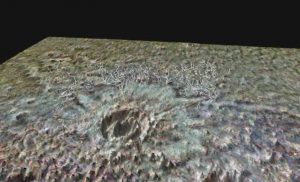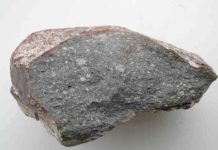
Present-day Mars is a frozen desert, colder and more arid than Antarctica, and scientists are fairly sure it’s been that way for at least the last 3 billion years. That makes a vast network of water-carved valleys on the flanks of an impact crater called Lyot — which formed somewhere between 1.5 billion and 3 billion years ago — something of a Martian mystery. It’s not clear where the water came from.
Now, a team of researchers from Brown University has offered what they see as the most plausible explanation for how the Lyot valley networks formed. They conclude that at the time of the Lyot impact, the region was likely covered by a thick layer of ice. The giant impact that formed the 225-kilometer crater blasted tons of blazing hot rock onto that ice layer, melting enough of it to carve the shallow valleys.
“Based on the likely location of ice deposits during this period of Mars’ history, and the amount of meltwater that could have been produced by Lyot ejecta landing on an ice sheet, we think this is the most plausible scenario for the formation of these valleys” said David Weiss, a recent Ph.D. graduate from Brown and the study’s lead author.
Weiss co-authored the study, which is published in Geophysical Research Letters, with advisor and Brown planetary science professor Jim Head, along with fellow graduate students Ashley Palumbo and James Cassanelli.
There’s plenty of evidence that water once flowed on the Martian surface. Water-carved valley networks similar to those at Lyot have been found in several locations. There’s also evidence for ancient lake systems, like those at Gale Crater where NASA’s Curiosity rover is currently exploring and at Jezero Crater where the next rover may land.
Most of these water-related surface features, however, date back to very early in Mars’ history — the epochs known as the Noachian and the Hesperian, which ended about 4 billion and 3 billion years ago respectively. From about 3 billion years ago to the present, Mars has been in a bone-dry period called the Amazonian.
The valley networks at Lyot therefore are a rare example of more recent surface water activity. Scientists have dated the crater itself to the Amazonian, and the valley networks appear to have been formed around the same time or shortly after the impact. So the question is: Where did all that water come from during the arid Amazonian?
Scientists have posited a number of potential explanations, and the Brown researchers set out to investigate several of the major ones.
One of those potential explanations, for example, is that there might have been a vast reservoir of groundwater when the Lyot impact occurred. That water, liberated by impact, could have flowed onto the surface along the periphery of the crater and carved the valleys. But based on geological evidence, the researchers say, that scenario is unlikely
“If these were formed by deep groundwater discharge, that water would have also flowed into the crater itself,” Weiss said. “We don’t see any evidence that there was water present inside the crater.”
The researchers also looked at the possibility of transient atmospheric effects following the Lyot impact. A collision of this size would have vaporized tons of rock, sending a plume of vapor into the air. As that hot plume interacted with the cold atmosphere, it could have produced rainfall that some scientists think might have carved the valleys.
But that, too, appears unlikely, the researchers concluded. Any rain related to the plume would have fallen after the rocky impact ejecta had been deposited outside the crater. So if rainwater carved the valleys, one would expect to see valleys cutting through the ejecta layer. But there are almost no valleys directly on the Lyot ejecta. Rather, Palumbo said, “The vast majority of the valleys seem to emerge from beneath the ejecta on its outer periphery, which casts serious doubt on the rainwater scenario.”
That left the researchers with the idea that meltwater, produced when hot ejecta interacted with an icy surface, carved the Lyot valleys.
According to models of Mars’ climate history, ice now trapped mainly at the planet’s poles often migrated into the mid-latitude regions where Lyot is located. And there’s evidence to suggest that an ice sheet was indeed present in the region at the time of the impact.
Some of that evidence comes from the scarcity of secondary craters at Lyot. Secondary craters form when big chunks of rock blasted into the air during a large impact fall back to the surface, leaving a smattering of small craters surrounding the main crater. At Lyot, there far fewer secondary craters than one would expect, the researchers say. The reason for that, they suggest, is that instead of landing directly on the surface, ejecta from Lyot landed on a thick layer of ice, which prevented it from gouging the surface beneath the ice. Based on the terrain on the northern side of Lyot, the team estimates that the ice layer could have been anywhere from 20 to 300 meters thick.
The Lyot impact would have spat tons of rock onto that ice layer, some of which would have been heated to 250 degrees Fahrenheit or more. Using a thermal model of that process, the researchers estimate that the interaction between those hot rocks and a surface ice sheet would have produced thousands of cubic kilometers of meltwater — easily enough to carve the valley seen at Lyot.
“What this shows is a way to get large amounts of liquid water on Mars without the need for a warming of the atmosphere and any liquid groundwater,” Cassanelli said. “So we think this is a good explanation for how you get these channels forming in the Amazonian.”
And it’s possible, Head says, that this same mechanism could have been important before the Amazonian. Some scientists think that even in the early Noachian and Hesperian epochs, Mars was still quite cold and icy. If that was the case, then this meltwater mechanism might have also been responsible for at least some of the more ancient valley networks on Mars.
“It’s certainly a possibility worth investigating,” Head said.
Reference:
David K. Weiss, James W. Head, Ashley M. Palumbo, James P. Cassanelli. Extensive Amazonian-aged fluvial channels on Mars: Evaluating the role of Lyot crater in their formation. Geophysical Research Letters, 2017; DOI: 10.1002/2017GL073821
Note: The above post is reprinted from materials provided by Brown University.










